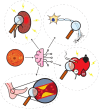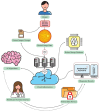Artificial intelligence for early detection of diabetes mellitus complications via retinal imaging
- PMID: 40224528
- PMCID: PMC11993533
- DOI: 10.1007/s40200-025-01596-7
Artificial intelligence for early detection of diabetes mellitus complications via retinal imaging
Abstract
Background: Diabetes mellitus (DM) increases the risk of vascular complications, and retinal vasculature imaging serves as a valuable indicator of both microvascular and macrovascular health. Moreover, artificial intelligence (AI)-enabled systems developed for high-throughput detection of diabetic retinopathy (DR) using digitized retinal images have become clinically adopted. This study reviews AI applications using retinal images for DM-related complications, highlighting advancements beyond DR screening, diagnosis, and prognosis, and addresses implementation challenges, such as ethics, data privacy, equitable access, and explainability.
Methods: We conducted a thorough literature search across several databases, including PubMed, Scopus, and Web of Science, focusing on studies involving diabetes, the retina, and artificial intelligence. We reviewed the original research based on their methodology, AI algorithms, data processing techniques, and validation procedures to ensure a detailed analysis of AI applications in diabetic retinal imaging.
Results: Retinal images can be used to diagnose DM complications including DR, neuropathy, nephropathy, and atherosclerotic cardiovascular disease, as well as to predict the risk of cardiovascular events. Beyond DR screening, AI integration also offers significant potential to address the challenges in the comprehensive care of patients with DM.
Conclusion: With the ability to evaluate the patient's health status in relation to DM complications as well as risk prognostication of future cardiovascular complications, AI-assisted retinal image analysis has the potential to become a central tool for modern personalized medicine in patients with DM.
Keywords: Artificial intelligence; Diabetes complications; Diabetes mellitus; Diabetic retinopathy; Retina.
© The Author(s) 2025.
Conflict of interest statement
Competing interestsThe authors declare that there is no conflict of interest.
Figures







Similar articles
-
Use of artificial intelligence with retinal imaging in screening for diabetes-associated complications: systematic review.EClinicalMedicine. 2025 Feb 18;81:103089. doi: 10.1016/j.eclinm.2025.103089. eCollection 2025 Mar. EClinicalMedicine. 2025. PMID: 40052065 Free PMC article. Review.
-
Evaluation of Artificial Intelligence Algorithms for Diabetic Retinopathy Detection: Protocol for a Systematic Review and Meta-Analysis.JMIR Res Protoc. 2024 May 27;13:e57292. doi: 10.2196/57292. JMIR Res Protoc. 2024. PMID: 38801771 Free PMC article.
-
Detection Rate of Diabetic Retinopathy Before and After Implementation of Autonomous AI-based Fundus Photograph Analysis in a Resource-Limited Area in Belize.Clin Ophthalmol. 2025 Mar 21;19:993-1006. doi: 10.2147/OPTH.S490473. eCollection 2025. Clin Ophthalmol. 2025. PMID: 40144136 Free PMC article.
-
Advancing Diabetic Retinopathy Screening: A Systematic Review of Artificial Intelligence and Optical Coherence Tomography Angiography Innovations.Diagnostics (Basel). 2025 Mar 15;15(6):737. doi: 10.3390/diagnostics15060737. Diagnostics (Basel). 2025. PMID: 40150080 Free PMC article. Review.
-
Artificial intelligence-based classification of cardiac autonomic neuropathy from retinal fundus images in patients with diabetes: The Silesia Diabetes Heart Study.Cardiovasc Diabetol. 2024 Aug 10;23(1):296. doi: 10.1186/s12933-024-02367-z. Cardiovasc Diabetol. 2024. PMID: 39127709 Free PMC article.
References
-
- Glovaci D, Fan W, Wong ND. Epidemiology of diabetes mellitus and cardiovascular disease. Curr Cardiol Rep. 2019;21(4):21. 10.1007/s11886-019-1107-y. - PubMed
-
- Arokiasamy P, Salvi S, Selvamani Y. Global burden of diabetes mellitus. Handbook of global health. Springer; 2021. pp. 1–44.
-
- Jeffcoate WJ, Harding KG. Diabetic foot ulcers. Lancet. 2003;361(9368):1545–51. 10.1016/S0140-6736(03)13169-8. - PubMed
-
- Cheung N, Mitchell P, Wong TY. Diabetic retinopathy. Lancet. 2010;376(9735):124–36. 10.1016/s0140-6736(09)62124-3. - PubMed
Publication types
LinkOut - more resources
Full Text Sources

